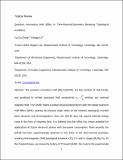| dc.contributor.author | Chang, Cui-zu | |
| dc.contributor.author | Li, Mingda | |
| dc.date.accessioned | 2018-09-13T18:37:07Z | |
| dc.date.available | 2018-09-13T18:37:07Z | |
| dc.date.issued | 2016-02 | |
| dc.date.submitted | 2015-04 | |
| dc.identifier.issn | 0953-8984 | |
| dc.identifier.issn | 1361-648X | |
| dc.identifier.uri | http://hdl.handle.net/1721.1/117747 | |
| dc.description.abstract | The quantum anomalous Hall effect (QAHE), the last member of Hall family, was predicted to exhibit quantized Hall conductivity αyx= e2/h without any external magnetic field. The QAHE shares a similar physical phenomenon with the integer quantum Hall effect (QHE), whereas its physical origin relies on the intrinsic topological inverted band structure and ferromagnetism. Since the QAHE does not require external energy input in the form of magnetic field, it is believed that this effect has unique potential for applications in future electronic devices with low-power consumption. More recently, the QAHE has been experimentally observed in thin films of the time-reversal symmetry breaking ferromagnetic (FM) topological insulators (TI), Cr- and V- doped (Bi,Sb)2Te3. In this topical review, we review the history of TI based QAHE, the route to the experimental observation of the QAHE in the above two systems, the current status of the research of the QAHE, and finally the prospects for future studies. | en_US |
| dc.description.sponsorship | United States. Department of Energy. Office of Basic Energy Sciences (Award DE-SC0001299) | en_US |
| dc.description.sponsorship | United States. Department of Energy. Office of Basic Energy Sciences (Award DE-FG02-09ER46577) | en_US |
| dc.publisher | IOP Publishing | en_US |
| dc.relation.isversionof | http://dx.doi.org/10.1088/0953-8984/28/12/123002 | en_US |
| dc.rights | Creative Commons Attribution-Noncommercial-Share Alike | en_US |
| dc.rights.uri | http://creativecommons.org/licenses/by-nc-sa/4.0/ | en_US |
| dc.source | arXiv | en_US |
| dc.title | Quantum anomalous Hall effect in time-reversal-symmetry breaking topological insulators | en_US |
| dc.type | Article | en_US |
| dc.identifier.citation | Chang, Cui-Zu, and Mingda Li. “Quantum Anomalous Hall Effect in Time-Reversal-Symmetry Breaking Topological Insulators.” Journal of Physics: Condensed Matter 28, 12 (March 2016): 123002 © 2016 IOP Publishing Ltd | en_US |
| dc.contributor.department | Massachusetts Institute of Technology. Department of Mechanical Engineering | en_US |
| dc.contributor.department | Massachusetts Institute of Technology. Laboratory for Nuclear Science | en_US |
| dc.contributor.department | Francis Bitter Magnet Laboratory (Massachusetts Institute of Technology) | en_US |
| dc.contributor.mitauthor | Chang, Cui-zu | |
| dc.contributor.mitauthor | Li, Mingda | |
| dc.relation.journal | Journal of Physics: Condensed Matter | en_US |
| dc.eprint.version | Author's final manuscript | en_US |
| dc.type.uri | http://purl.org/eprint/type/JournalArticle | en_US |
| eprint.status | http://purl.org/eprint/status/PeerReviewed | en_US |
| dc.date.updated | 2018-09-13T13:39:32Z | |
| dspace.orderedauthors | Chang, Cui-Zu; Li, Mingda | en_US |
| dspace.embargo.terms | N | en_US |
| dc.identifier.orcid | https://orcid.org/0000-0001-7413-5715 | |
| dc.identifier.orcid | https://orcid.org/0000-0002-7055-6368 | |
| mit.license | OPEN_ACCESS_POLICY | en_US |
